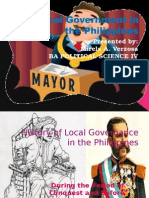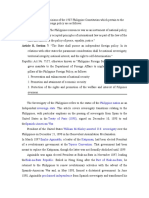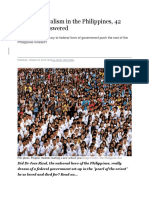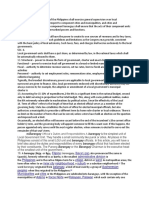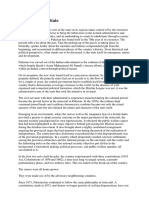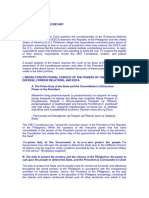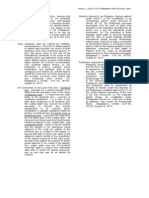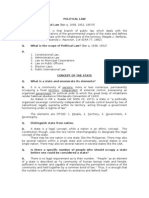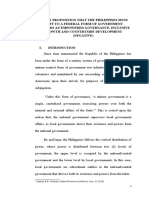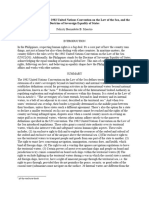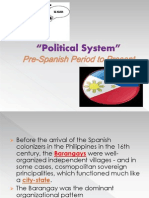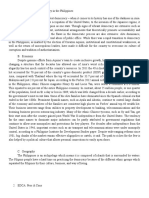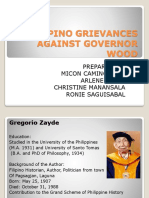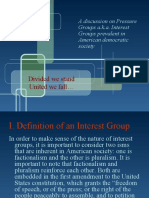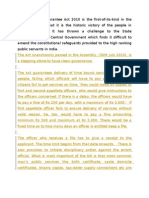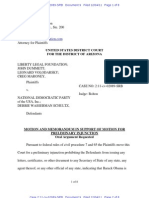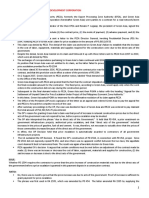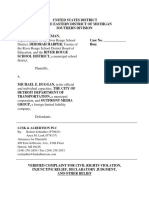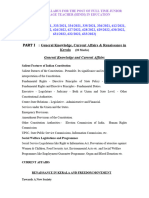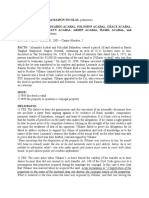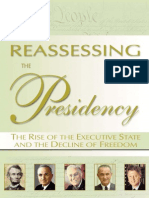0 ratings0% found this document useful (0 votes)
47 viewsFerdinand Marcos Jabidah Massacre
Ferdinand Marcos Jabidah Massacre
Uploaded by
quail09The document discusses the history and evolution of the Moro Islamic Liberation Front (MILF) separatist movement in the Philippines. It began in the 1960s after Muslim trainees were massacred by government forces. The movement sought an independent Bangsamoro nation and engaged in armed conflict with the government for decades. Several peace agreements and autonomous regions were established but issues remained around the scope of powers and whether independence or autonomy should be pursued. The proposed Memorandum of Agreement on the Ancestral Domain would have granted the new Bangsamoro Juridical Entity state-like powers and status, but this was inconsistent with the Philippine constitution.
Copyright:
© All Rights Reserved
Available Formats
Download as DOC, PDF, TXT or read online from Scribd
Ferdinand Marcos Jabidah Massacre
Ferdinand Marcos Jabidah Massacre
Uploaded by
quail090 ratings0% found this document useful (0 votes)
47 views8 pagesThe document discusses the history and evolution of the Moro Islamic Liberation Front (MILF) separatist movement in the Philippines. It began in the 1960s after Muslim trainees were massacred by government forces. The movement sought an independent Bangsamoro nation and engaged in armed conflict with the government for decades. Several peace agreements and autonomous regions were established but issues remained around the scope of powers and whether independence or autonomy should be pursued. The proposed Memorandum of Agreement on the Ancestral Domain would have granted the new Bangsamoro Juridical Entity state-like powers and status, but this was inconsistent with the Philippine constitution.
Original Description:
jurisprudence peace process
Original Title
Peace Process
Copyright
© © All Rights Reserved
Available Formats
DOC, PDF, TXT or read online from Scribd
Share this document
Did you find this document useful?
Is this content inappropriate?
The document discusses the history and evolution of the Moro Islamic Liberation Front (MILF) separatist movement in the Philippines. It began in the 1960s after Muslim trainees were massacred by government forces. The movement sought an independent Bangsamoro nation and engaged in armed conflict with the government for decades. Several peace agreements and autonomous regions were established but issues remained around the scope of powers and whether independence or autonomy should be pursued. The proposed Memorandum of Agreement on the Ancestral Domain would have granted the new Bangsamoro Juridical Entity state-like powers and status, but this was inconsistent with the Philippine constitution.
Copyright:
© All Rights Reserved
Available Formats
Download as DOC, PDF, TXT or read online from Scribd
Download as doc, pdf, or txt
0 ratings0% found this document useful (0 votes)
47 views8 pagesFerdinand Marcos Jabidah Massacre
Ferdinand Marcos Jabidah Massacre
Uploaded by
quail09The document discusses the history and evolution of the Moro Islamic Liberation Front (MILF) separatist movement in the Philippines. It began in the 1960s after Muslim trainees were massacred by government forces. The movement sought an independent Bangsamoro nation and engaged in armed conflict with the government for decades. Several peace agreements and autonomous regions were established but issues remained around the scope of powers and whether independence or autonomy should be pursued. The proposed Memorandum of Agreement on the Ancestral Domain would have granted the new Bangsamoro Juridical Entity state-like powers and status, but this was inconsistent with the Philippine constitution.
Copyright:
© All Rights Reserved
Available Formats
Download as DOC, PDF, TXT or read online from Scribd
Download as doc, pdf, or txt
You are on page 1of 8
History
In the midst of the martial law regime during the 1960s, a
geopolitical revolutionary movement in the Philippines was
born and will continue to exist today a movement that will
shape the political, social and economic landscape of the
Philippines for almost half a century!
It was said that sometime in 196", #" $uslim volunteers were
massacred by government troops in what was %nown as the
&abidah $assacre, and which is widely considered as the
catalyst that birthed the Islamic separatist movements in
$indanao!
In 1" $arch 196", between 1' to 6" (ilipino $uslim military
trainees were massacred in )orregidor by soldiers of the
*rmed (orces of the Philippines +*(P, under its )ommander in
)hief President (erdinand $arcos! It was popularly called
the &abidah $assacre!
-he impact was an outrage among the $uslims in $indanao
especially those who are from .ulu where these military
trainees were recruited! /ot ta%ing this lightly, /ur $isuari, a
0niversity of the Philippines professor rose to become the
leader of this outraged group and he founded the $oro
/ational 1iberation (ront in 1969!
-he original aim of this movement is the liberation of the $oro
nation from the terror, oppression and tyranny of (ilipino
colonialism and to secure a free and independent state for the
2angsa $oro people!
In pursuit of their goal of liberating the 2angsamoro, the $/1(
engaged the government forces in extensive armed collisions
and insurgencies, to the extent that the $/1( even held a
substantial number of municipalities under its control!
-his movement caused tremendous impact on the
government! (or nearly 3ve decades and 3ve presidents, they
have tried to completely put an end to these rebellions,
utili4ing either force or diplomacy!
-hus, because of the tremendous impact of this movement,
the then $arcos regime tried to beef up its military presence in
most $uslim parts in $indanao! 2ut this was never enough!
(ortunately, in what was considered as the 3rst victory, the
-ripolo *greement was signed in 1956, which introduced the
concept of an autonomous $uslim region in $indanao!
-his was later on incorporated in the 19"5 Philippine
)onstitution and in fact, later on, during the *6uino
administration, )ongress enacted the creation of *utonomous
7egion in $uslim $indanao! 0nfortunately, the problem with
the creation of *7$$ was that out of 18 provinces and 9 cities,
only ' provinces became part of the *7$$!
9orse, the creation of *7$$ further divided the $/1(! Instead
of bringing $uslim leaders together, it fragmented the $/1(
because some factions within the group preferred
independence over autonomy! )onse6uently, the group of
Hashim .alamat bro%e away and formed the $oro Islamic
1iberation front to continue their armed struggle for an
independent 2angsamoro nation in $indanao!
/egotiations were pursued during the 7amos administration
with this new movement!
:uring the ;strada administration, there was a sudden shift of
policy! Instead of exerting diplomatic e<orts, President ;strada
declared an all out war against the $I1(!
;strada=s all out war led to the capture of )amp *buba%ar, the
main head 6uarter of the $I1(!
0nder the *rroyo administration, several rounds of
negotiations were pursued, which would eventually fail
because of military involvement and activities! -he most
signi3cant contribution of the *rroyo administration was the
creation of the $emorandum of *greement on the $uslim
*ncestral :omain, or the $>*?*:!
0nder the proposed memorandum of agreement on ancestral
domain +$>*?*:,, the planned homeland also referred to as
the 2angsamoro &uridical ;ntity +2&;, was to include the
*utonomous 7egion in $uslim $indanao +.ulu, $aguindanao,
1anao del .ur, -awi?-awi, 2asilan and $arawi )ity,@ six
municipalities in 1anao del /orte@ hundreds of villages in the
provinces of .ultan Audarat, 1anao del /orte and /orth
)otabato, which voted in #001 to become part of the *7$$@
and parts of Palawan!
It was to have its own Bbasic law,C police and internal security
force, and system of ban%ing and 3nance, civil service,
education and legislative and electoral institutions, as well as
full authority to develop and dispose of minerals and other
natural resources!
-he $>*?*: is inconsistent with the )onstitution and laws as
presently worded!
In general, the obDections against the $>*?*: center on the
extent of the powers conceded therein to the 2&;! Petitioners
assert that the powers granted to the 2&; exceed those
granted to any local government under present laws, and even
go beyond those of the present *7$$! 2efore assessing some
of the speci3c powers that would have been vested in the 2&;,
however, it would be useful to turn 3rst to a general idea that
serves as a unifying lin% to the di<erent provisions of the $>*?
*:, namely, the international law concept of association!
.igni3cantly, the $>*?*: explicitly alludes to this concept,
indicating that the Parties actually framed its provisions with it
in mind!
2ac% to the $>*?*:, it contains many provisions which are
consistent with the international legal concept of association,
speci3cally the followingE the 2&;Fs capacity to enter into
economic and trade relations with foreign countries, the
commitment of the )entral Government to ensure the 2&;Fs
participation in meetings and events in the *.;*/ and the
speciali4ed 0/ agencies, and the continuing responsibility of
the )entral Government over external defense! $oreover,
the 2&;Fs right to participate in Philippine oHcial missions
bearing on negotiation of border agreements, environmental
protection, and sharing of revenues pertaining to the bodies of
water adDacent to or between the islands forming part of the
ancestral domain, resembles the right of the governments of
(.$ and the $arshall Islands to be consulted by the 0!.!
government on any foreign a<airs matter a<ecting them!
-hese provisions of the $>* indicate, among other things, that
the Parties aimed to vest in the 2&; the status of an associated
state or, at any rate, a status closely approximating it!
-he concept of association is not recogni4ed under the present
)onstitution
/o province, city, or municipality, not even the *7$$, is
recogni4ed under our laws as having an IassociativeI
relationship with the national government! Indeed, the concept
implies powers that go beyond anything ever granted by the
)onstitution to any local or regional government! It also implies
the recognition of the associated entity as a state! -he
)onstitution, however, does not contemplate any state in this
Durisdiction other than the Philippine .tate, much less does it
provide for a transitory status that aims to prepare any part of
Philippine territory for independence!
;ven the mere concept animating many of the $>*?*:Fs
provisions, therefore, already re6uires for its validity the
amendment of constitutional provisions, speci3cally the
following provisions of *rticle JE
.;)-I>/ 1! -he territorial and political subdivisions of the
7epublic of the Philippines are the provinces, cities,
municipalities, and barangays! -here shall be autonomous
regions in $uslim $indanao and the )ordilleras as hereinafter
provided!
.;)-I>/ 1K! -here shall be created autonomous regions in
$uslim $indanao and in the )ordilleras consisting of provinces,
cities, municipalities, and geographical areas sharing common
and distinctive historical and cultural heritage, economic and
social structures, and other relevant characteristics within the
framewor% of this )onstitution and the national sovereignty as
well as territorial integrity of the 7epublic of the Philippines!
-he 2&; is a far more powerful
entity than the autonomous region
recogni4ed in the )onstitution
It is not merely an expanded version of the *7$$, the status
of its relationship with the national government being
fundamentally di<erent from that of the *7$$! Indeed, 2&; is a
state in all but name as it meets the criteria of a state laid
down in the $ontevideo )onvention,
1K'
namely, a permanent
population, a de3ned territory, a government, and a capacity
to enter into relations with other states!
;ven assuming arguendo that the $>*?*: would not
necessarily sever any portion of Philippine territory, the spirit
animating it ? which has betrayed itself by its use of the
concept of association ? runs counter to the national
sovereignty and territorial integrity of the 7epublic!
-he de3ning concept underlying the relationship between the
national government and the 2&; being itself contrary to the
present )onstitution, it is not surprising that many of the
speci3c provisions of the $>*?*: on the formation and powers
of the 2&; are in conLict with the )onstitution and the laws!
*rticle J, .ection 1" of the )onstitution provides that IMtNhe
creation of the autonomous region shall be e<ective when
approved by a maDority of the votes cast by the constituent
units in a plebiscite called for the purpose, provided that only
provinces, cities, and geographic areas voting favorably in
such plebiscite shall be included in the autonomous region!I
+;mphasis supplied,
*s reLected above, the 2&; is more of a state than an
autonomous region! 2ut even assuming that it is covered by
the term Iautonomous regionI in the constitutional provision
Dust 6uoted, the $>*?*: would still be in conLict with it! 0nder
paragraph #+c, on -;77I->7O in relation to #+d, and #+e,, the
present geographic area of the *7$$ and, in addition, the
municipalities of 1anao del /orte which voted for inclusion in
the *7$$ during the #001 plebiscite - Baloi, Munai, Nunungan,
Pantar, Tagoloan and Tangkal ? are automatically part of the
2&; without need of another plebiscite, in contrast to the areas
under )ategories * and 2 mentioned earlier in the overview!
-hat the present components of the *7$$ and the above?
mentioned municipalities voted for inclusion therein in #001,
however, does not render another plebiscite unnecessary
under the )onstitution, precisely because what these areas
voted for then was their inclusion in the *7$$, not the 2&;!
-he *6uino administration resumed once again peace
negotiations with the $I1(, and last $arch #5, #01', the
)omprehensive *greement on the 2angsamoro was signed
and witnessed by our President, $I1( )hairman and $alaysian
Prime $inister!
9hat is the implication of the )omprehensive *greement on
the 2angsamoroP
-he agreement would pave the way for the creation of the new
$uslim autonomous entity called B2angsamoroC under a law to
be approved by the Philippine )ongress! -he agreement calls
for $uslim self?rule in parts of the southern Philippines in
exchange for deactivation of rebel forces by the $I1(!
-he agreement recogni4es Bthe Dustness and legitimacy of the
cause of the 2angsamoro people, their aspiration for
meaningful autonomy through a democratic process@ the aim
of 3nding a solution to the 2angsamoro 6uestion with honor,
Dustice, and dignity@ the aim to end the 3ghting between the
government and the $I1( and promote peace and stability@ the
recognition of the responsibilities of the parties to protect and
enhance the rights of the 2angsamoro people and all other
inhabitants, correct historical inDustice, and e6uitably di<use
wealth and political power!C
-he 2angsamoro autonomous political entity will replace the
*utonomous 7egion in $uslim $indanao +*7$$, by #016! It
will be presided over by a ministerial form of government! It is
not an Islamic state!
However, the scope of its territory will be settled after a
plebiscite on the 2angsamoro 2asic 1aw!
-he ministerial government, which will be in the form of an
assembly with an elected chief minister, will have an
Basymmetric relationshipC with the national government!
-he 2angsamoro 2asic 1aw, which is still being drafted, will
de3ne the relations of the local government units, the
2angsamoro government and the central government!
-he *nnex on Power .haring states that the relationship
should be BreLective of the recognition of the 2angsamoro
identity and their aspiration for self?governance!C
)ivil courts for non?$uslims will be maintained while .haria
courts for $uslims will be established! * Dudicial process for
indigenous rights will also be allotted for!
-he 2angsamoro government will have taxing powers similar
to that of the *7$$! It will collect funds from fees and charges,
grants and donations, loans and other sources of revenues! >f
the national taxes, fees and charges collected by the central or
national government within the territory, 5K percent will go to
the 2angsamoro government! In the long?run, the 2angsamoro
should be less dependent on the national government!
)riti6ue on the new agreementE
.he said the Philippine governmentFs agreement with the $oro
Islamic 1iberation (ront is unconstitutional becauseE
the government panel and the *6uino administration
ImisrepresentedI themselves as the Philippine
government and went beyond its authority@
the entity that will replace the *utonomous 7egion for
$uslim $indanao is a Isubstate,I not provided for in the
19"5 )onstitution, and will have powers that IdiminishesI
the sovereignty of the Philippine government@ and
the agreement gives the governmentFs IconsentI to
amend the )onstitution!
9hat were the causes the peace negotiations have made little
progress over the past years and decadesP
1! Qarious disruptions of hostilities
#! )ompeting policy positions
8! :i<erent negotiating strategies and obDectives
characteri4ed by incrementality
'! .tructural obstacles
9hat has been achieved over the past yearsP
-hat the negotiations have survived decades is a testament to
its secure place in the whole peace process!
-he most important gain is in the building of framewor%s and
terms of reference, which lay for substantial progress therein!
)ease3re mechanisms have been in placed
International third party facilitation
Growing civil society participation
You might also like
- Constitutional and Philippine Political LawDocument45 pagesConstitutional and Philippine Political LawChariss Garcia100% (1)
- GROUP 7 Filipino Grievances Against Governor WoodDocument26 pagesGROUP 7 Filipino Grievances Against Governor WoodMicon Dumip-ig CamingawanNo ratings yet
- Annotated BibliographyDocument17 pagesAnnotated Bibliographyapi-193243031No ratings yet
- Lehi Barlow Jeffs OpinionDocument40 pagesLehi Barlow Jeffs OpinionBen WinslowNo ratings yet
- City of Cebu - ClampingDocument8 pagesCity of Cebu - ClampingDael GerongNo ratings yet
- Summary of Issues and Arguments On The BBLDocument53 pagesSummary of Issues and Arguments On The BBLiagorgphNo ratings yet
- Legal Overview of Philippine Indigenous People's RightsDocument8 pagesLegal Overview of Philippine Indigenous People's RightsJohn Michael Babas100% (1)
- Activity 3 ContemDocument7 pagesActivity 3 ContemTommy PascuaNo ratings yet
- Liberty of Abode and Travel DigestsDocument4 pagesLiberty of Abode and Travel DigestsLen Vicente - FerrerNo ratings yet
- PPG Handouts CHAPTER 9Document4 pagesPPG Handouts CHAPTER 9Jason BinondoNo ratings yet
- Doctrine of Effective Occupation-DiscoveryDocument4 pagesDoctrine of Effective Occupation-DiscoveryNesthyne EusebioNo ratings yet
- States, Nations-WPS OfficeDocument50 pagesStates, Nations-WPS OfficekerbydarjuanNo ratings yet
- Local Government in The Philippines1Document59 pagesLocal Government in The Philippines1Kent Alvin GuzmanNo ratings yet
- The Local GovernmentDocument18 pagesThe Local GovernmentViper VixenNo ratings yet
- 2Document4 pages2Karyl Mae Bustamante OtazaNo ratings yet
- Report IP Rights - With Personal NotesDocument5 pagesReport IP Rights - With Personal NotesAnonymous iOYkz0wNo ratings yet
- Democracy in The Philippines Ponape: A Comparison of Two Political Structured The U. S. ModepDocument10 pagesDemocracy in The Philippines Ponape: A Comparison of Two Political Structured The U. S. ModepKeiren Faith BaylonNo ratings yet
- Pinoy: Federalism in The Philippines, 42 Questions AnsweredDocument47 pagesPinoy: Federalism in The Philippines, 42 Questions AnsweredlukeNo ratings yet
- A Background On The 1987 ConstitutionDocument9 pagesA Background On The 1987 ConstitutionDennis RaymundoNo ratings yet
- Marcos v. ManglapusDocument2 pagesMarcos v. Manglapuscatrina lobatonNo ratings yet
- THBT The Philippines Should Adopt A Federal Form of GovernmentDocument4 pagesTHBT The Philippines Should Adopt A Federal Form of GovernmentEmerey MendezNo ratings yet
- Exercise 13Document4 pagesExercise 13Erwinn MonsantoNo ratings yet
- PPG Chapter 1Document37 pagesPPG Chapter 1Genelyn BelloNo ratings yet
- Is The Philippines A State or A NationDocument2 pagesIs The Philippines A State or A NationHeherson Custodio78% (9)
- North Cotabato Vs GRP Peace Panel On Ipra LawDocument5 pagesNorth Cotabato Vs GRP Peace Panel On Ipra LawJazz OrtegaNo ratings yet
- The State of The StateDocument18 pagesThe State of The StateYousuf Shah KhaggaNo ratings yet
- PIL DIGEST 2 FULL TEXTDocument73 pagesPIL DIGEST 2 FULL TEXTMary grace ApostolNo ratings yet
- Atty Jeffrey C. SaclotDocument3 pagesAtty Jeffrey C. SaclotejemjunrexNo ratings yet
- Int Cerd Ngo Fji 13662 eDocument51 pagesInt Cerd Ngo Fji 13662 edenisNo ratings yet
- Cons ReviewerDocument91 pagesCons ReviewerJames GonzalesNo ratings yet
- Philippine-Constitution ReviewerDocument2 pagesPhilippine-Constitution Revieweryangobryant16No ratings yet
- Ps NationDocument12 pagesPs Nationjambit03100% (1)
- Patrimony and Economy Foreign Investments ActDocument14 pagesPatrimony and Economy Foreign Investments ActRyan MostarNo ratings yet
- History of LGUsDocument32 pagesHistory of LGUsgolempekka499No ratings yet
- Readings in Philippine HistoryDocument10 pagesReadings in Philippine HistoryGlen Jhon TejeroNo ratings yet
- The Friar Land ScandalDocument10 pagesThe Friar Land ScandalRod Herrero PinoNo ratings yet
- Finals Reviewer PDFDocument25 pagesFinals Reviewer PDFKae Supnad100% (2)
- Cordillera FactsDocument8 pagesCordillera FactsPatNo ratings yet
- L. C ' 2013 R P L: Arlo RUZ S Eminders FOR Olitical AWDocument42 pagesL. C ' 2013 R P L: Arlo RUZ S Eminders FOR Olitical AWtigerlilyicedtea1No ratings yet
- Federalism in The PhilippinesDocument36 pagesFederalism in The PhilippinesMabelle Esconde Acosta68% (22)
- Sample QuestionDocument8 pagesSample Questionlooke_72No ratings yet
- Position Paper Draft (FEDERALISM)Document32 pagesPosition Paper Draft (FEDERALISM)Bryan Ramirez RamonesNo ratings yet
- Stat Con LetterDocument25 pagesStat Con LetterLeigh GanancialNo ratings yet
- The Concept of The StateDocument52 pagesThe Concept of The StateMau ElijahNo ratings yet
- Bangsamoro Basic Law - PresentationDocument20 pagesBangsamoro Basic Law - PresentationFatimah MandanganNo ratings yet
- A Synthesis Paper On The 1982 United Nations Convention On The Law of The SeaDocument4 pagesA Synthesis Paper On The 1982 United Nations Convention On The Law of The SeafelicitybernadettemaestroNo ratings yet
- Political System Ppt. (Final)Document40 pagesPolitical System Ppt. (Final)Lharra Cagulada-PostranoNo ratings yet
- Constitutional Law 1 NotesDocument60 pagesConstitutional Law 1 Notessunsetsailor8589% (9)
- Marcos V Manglapus G.R. No. 88211. September 15, 1989Document11 pagesMarcos V Manglapus G.R. No. 88211. September 15, 1989MWinbee VisitacionNo ratings yet
- Factors Affecting Democracy in The PhilippinesDocument3 pagesFactors Affecting Democracy in The PhilippinesRon Olegario100% (1)
- Marcos v. ManglapusDocument26 pagesMarcos v. ManglapusMarkAnthonyAlonzoTorresNo ratings yet
- Liberty of Abode and of TravelDocument12 pagesLiberty of Abode and of TravelEnric AlcaideNo ratings yet
- Article IV Citizenship: OF ReportsDocument21 pagesArticle IV Citizenship: OF ReportskiraNo ratings yet
- Constitutions of The Republic of The Philippines ConstitutionDocument18 pagesConstitutions of The Republic of The Philippines ConstitutionJoan Mila CoNo ratings yet
- GROUP 7 Filipino Grievances Against Governor WoodDocument26 pagesGROUP 7 Filipino Grievances Against Governor WoodMicon Dumip-ig Camingawan100% (1)
- Divided We Stand United We FallDocument38 pagesDivided We Stand United We FallGlenn RiveraNo ratings yet
- Guido vs. Rural ProgressDocument9 pagesGuido vs. Rural Progressstaircasewit4No ratings yet
- G.R. No. L-2089 October 31, 1949Document6 pagesG.R. No. L-2089 October 31, 1949Rache BaodNo ratings yet
- Preamble: Case Digests Political LawDocument6 pagesPreamble: Case Digests Political LawAnNie PascualNo ratings yet
- Chacha ArticleDocument4 pagesChacha Articlepinkvirgo006No ratings yet
- Argumentative EssayDocument3 pagesArgumentative EssayCharisse Aleli DoyonganNo ratings yet
- 75 Tropical Hut Employees' Union-Cgw vs. Tropical Hut - DigestDocument3 pages75 Tropical Hut Employees' Union-Cgw vs. Tropical Hut - DigestNylaNo ratings yet
- Man Bhadur Biswakarma Vs HMGDocument3 pagesMan Bhadur Biswakarma Vs HMGdurgamagar72772No ratings yet
- Final Narrative Report - Rox BulusanDocument27 pagesFinal Narrative Report - Rox BulusanRoxanne Mateo MatiasNo ratings yet
- Disbarment Vs Gadon DraftDocument12 pagesDisbarment Vs Gadon DraftIndomitable RakoNo ratings yet
- Lindahl v. Office of Personnel Management, 470 U.S. 768 (1985)Document36 pagesLindahl v. Office of Personnel Management, 470 U.S. 768 (1985)Scribd Government DocsNo ratings yet
- Delgado V Araguz: Petition For Review Filed On Behalf of Heather DelgadoDocument111 pagesDelgado V Araguz: Petition For Review Filed On Behalf of Heather DelgadoDaniel WilliamsNo ratings yet
- Constitutional Law 2 NotesDocument2 pagesConstitutional Law 2 NotesYands008No ratings yet
- 015 Dept. of Education vs. OñateDocument3 pages015 Dept. of Education vs. OñateKelsey Olivar MendozaNo ratings yet
- Common Cause v. UOIDocument24 pagesCommon Cause v. UOILive LawNo ratings yet
- Taxation Law Ii A.Y. 2018-2019: Case Title: Bpi V. Cir G.R. No/Date: G.R. No. 139736. October 17, 2005Document3 pagesTaxation Law Ii A.Y. 2018-2019: Case Title: Bpi V. Cir G.R. No/Date: G.R. No. 139736. October 17, 2005Czarina CidNo ratings yet
- Public Service Guarantee Act 2010 Is The FirstDocument3 pagesPublic Service Guarantee Act 2010 Is The Firstkrithi13No ratings yet
- LIBERTY LEGAL, Et Al. V National Democratic Party, Et Al. (D.Az.) - LLF Motion For Preliminary Injunction (12/4/2011)Document8 pagesLIBERTY LEGAL, Et Al. V National Democratic Party, Et Al. (D.Az.) - LLF Motion For Preliminary Injunction (12/4/2011)Jack RyanNo ratings yet
- Funda NewDocument8 pagesFunda NewSourav SutradharNo ratings yet
- Barroso Vs Omelio 772 SCRA 437, GR 194767 (Oct. 14, 2015)Document6 pagesBarroso Vs Omelio 772 SCRA 437, GR 194767 (Oct. 14, 2015)Lu CasNo ratings yet
- 15 People V SozaDocument2 pages15 People V Sozared gyn100% (1)
- Agenda of The 107th Regular SessionDocument82 pagesAgenda of The 107th Regular SessionCdeoCityCouncilNo ratings yet
- High Court Decsion 1Document8 pagesHigh Court Decsion 1Yasir NasimNo ratings yet
- 2 Carandang vs. DesiertoDocument19 pages2 Carandang vs. DesiertoJeliza ManaligodNo ratings yet
- Facts:: Peza vs. Green Asia Construction & Development CorporationDocument2 pagesFacts:: Peza vs. Green Asia Construction & Development CorporationTrisha Ace Betita ElisesNo ratings yet
- Mini-Lesson 2 French Revolution Crises StageDocument4 pagesMini-Lesson 2 French Revolution Crises Stagec. reyesNo ratings yet
- Right To HealthDocument29 pagesRight To HealthRahul Singh100% (2)
- Ddot ComplaintDocument24 pagesDdot ComplaintAnonymous Zv16j2aNo ratings yet
- General Education 7.1Document6 pagesGeneral Education 7.1EnricoZamoraSantiagoNo ratings yet
- FTJLT - PTJLT HindiDocument4 pagesFTJLT - PTJLT HindiSruthiHappy soulNo ratings yet
- Acabal V Acabal Property DigestDocument2 pagesAcabal V Acabal Property DigestRossette AnasarioNo ratings yet
- Reassessing PresidencyDocument830 pagesReassessing PresidencyIvan JanssensNo ratings yet
- Laperal vs. RepublicDocument3 pagesLaperal vs. RepublicInna LadislaoNo ratings yet












